Situated in the heart of the Great Plains, Nebraska’s plant hardiness zones are much more uniform than those in many other states. Nebraska ranges from Zones 4b to 5b, with a tiny region in the far northwest part of the state classified as Zone 4a.
When it comes to tulips, that makes things very simple. The hardiness zones of Nebraska are tulip paradise!
The cold Nebraska winters provide ideal conditions for tulip bulbs to develop so they can bloom in a dazzling spring display.
Get to Know the Tulip
The Tulipa genus includes around 150 species with over 3,000 cultivars. They are divided into 15 different classifications based on shape, height, and when they bloom.
| Tulip Facts | |
|---|---|
| Botanical name | Tulipa spp. |
| Common Name | Tulip |
| Plant Type | Perennial, bulb |
| Sunlight | Full |
| Soil | Rich, well-drained |
| Bloom Season | Spring |
| Toxicity | Toxic to both humans and pets |
Types
Tulips present a virtually limitless number of options for gardeners. While this is by no means an exhaustive list, here are four types of tulips that are perfect for growing in the Cornhusker State.
1. Red Riding Hood Tulip
Part of the Greigii group of tulips, this variety features purple-mottled foliage and eye-catching scarlet red flowers with small black hearts inside.
Introduced in 1953, this tulip is an early to mid-spring blooming flower. And bonus points are awarded to this tulip because of its beautifully unique leaves. After the bloom is gone, the foliage will still add an interesting dynamic to your garden.
The Red Riding Hood is recommended for growing in Zones 3-8, which makes it an ideal choice for every Nebraska tulip grower.
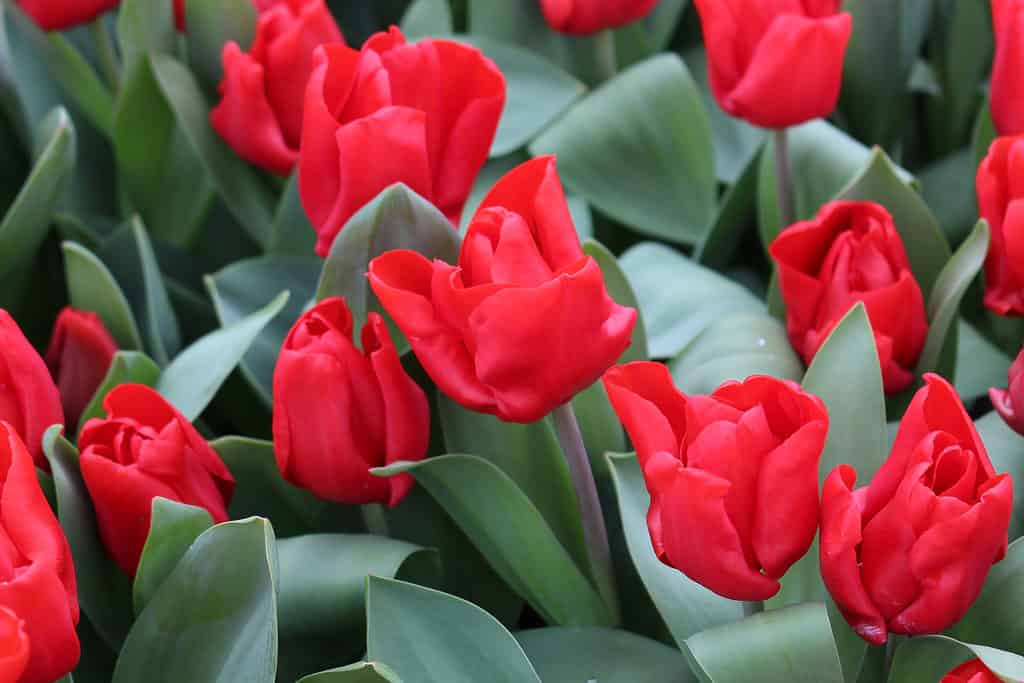
Bed of blooming Red Riding Hood Tulips.
©Tatiana Alex/Shutterstock.com
2. Golden Apeldoorn Tulip
The Golden Apeldoorn tulip is a member of the Darwin Hybrid group. Darwin Hybrids are some of the most popular tulip cultivars on the market because of their reliability, hardiness, and beauty.
The Golden Apeldoorn produces a gorgeous golden-yellow bloom atop its exceptionally sturdy stem. These stout stems can really stand up to the unpredictable conditions of a Nebraska spring.
Topping out at Zone 7, these tulips would not be a good idea for growers in warmer climates, but they are tailor-made for growing in Nebraska!
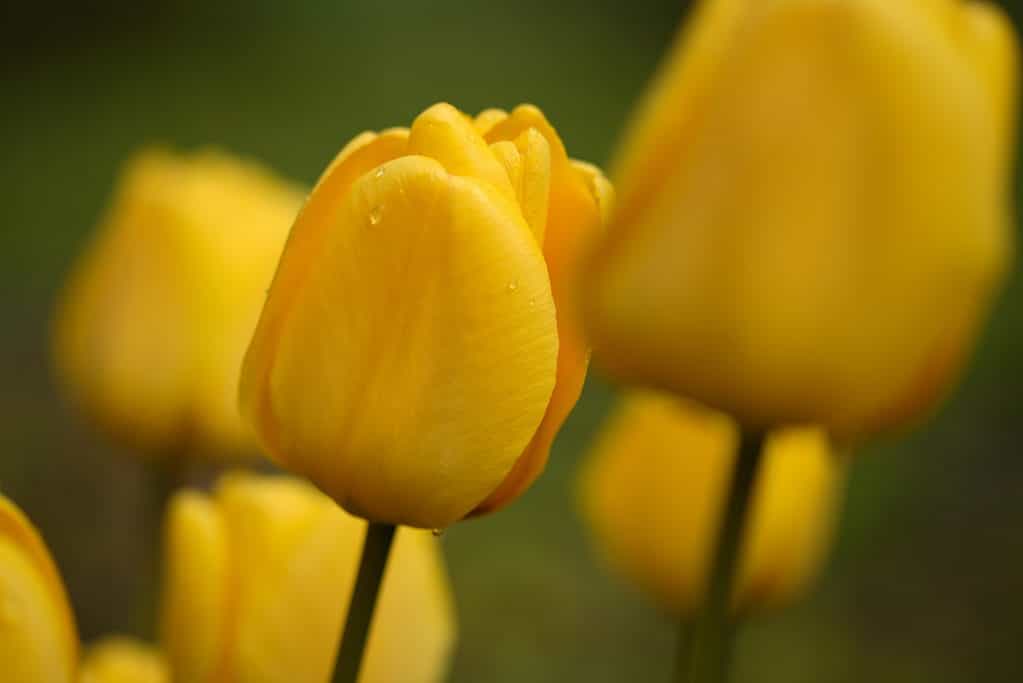
Golden Apeldoorn Darwin hybrid tulips in bloom.
©Bildagentur Zoonar GmbH/Shutterstock.com
3. Blushing Lady Tulip
This tulip fits its common name perfectly, featuring large creamy yellow lily-shaped blossoms accented with a blushing pink hue on the sides.
The Blushing Lady is part of the Single Late group of tulips. Single Lates have some of the biggest blooms and the most vibrant colors of any tulip variety. Plus, as the name Single Late suggests, they bloom later than many other tulip varieties, so they are perfect for extending the spring blooming season in your flowerbed or garden.
Recommended for growing in Zones 3-8, the Blushing Lady can coquettishly show her face in any Nebraska tulip garden throughout the state.
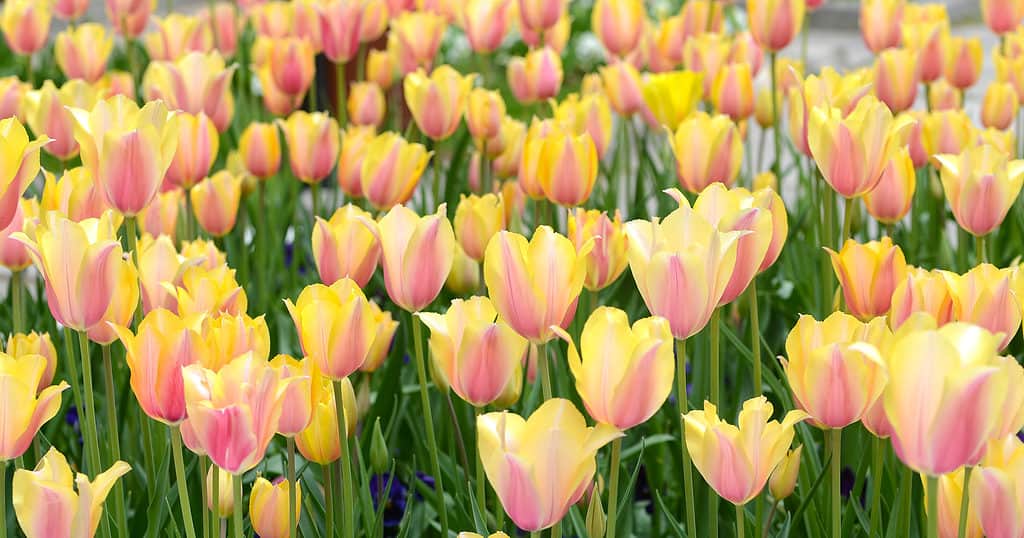
Field filled with yellow and pink Blushing Lady Tulips in bloom.
©Artography/Shutterstock.com
4. Don Quichotte Tulip
If you’re looking to add some beautiful pink hues to your spring landscape, you need to get to know the Don Quichotte Tulip! Its deep pink, with hints of purple, will really “pop” and will be a wonderful accent to other varieties and colors of spring flowers in your display.
Triumph tulips are the largest tulip group by a wide margin. They are also some of the most sturdy, with stems that can withstand heavy wind and rain.
Recommended for Zones 3-8, gardeners can grow Triumphs in every corner of the Cornhusker State. If the Don Quichotte isn’t available in your area, try one of the other Triumphs.
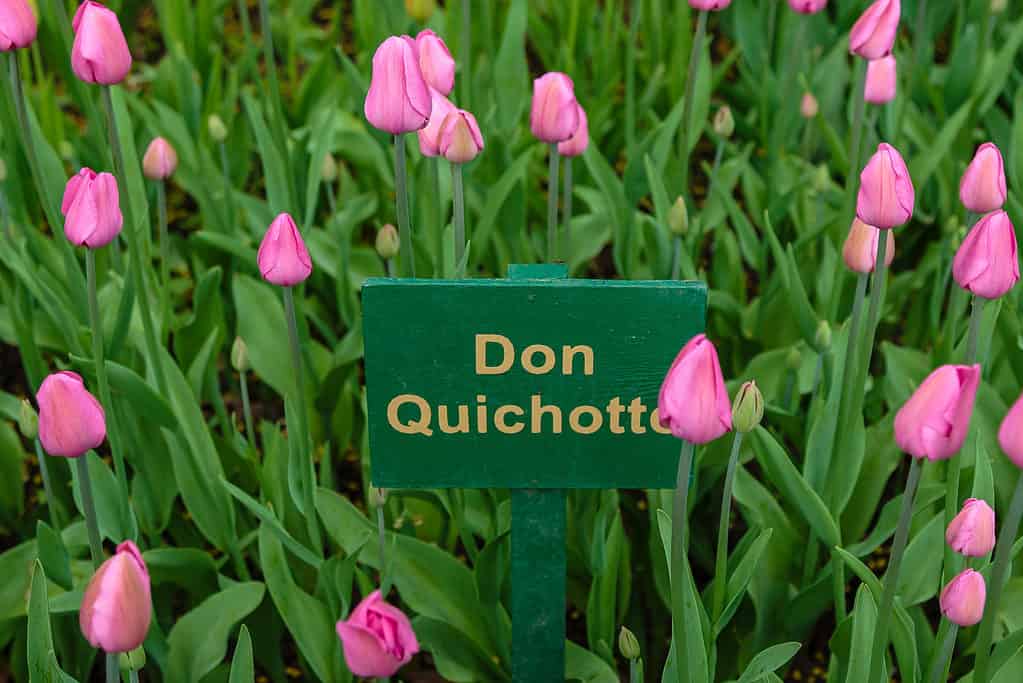
A bed of pink Don Quichotte Tulips with a sign.
©Flower_Garden/Shutterstock.com
5. Exotic Emperor Tulip
Emperor (also known as Fosteriana) tulips bloom in early spring. The Exotic Emperor (sometimes called White Valley) is possibly the earliest blooming double-white tulip available today.
This tulip features creamy yellow blooms that turn to an ivory hue as they mature, with light yellow flames and green strips on the outer petals. This is one endlessly interesting flower!
Emperor tulips are so-named because of their oversized bowl-shaped flowers. They can grow to heights of around 20 inches.
Ideal for Zones 3-7, this is another tulip that will be right at home wherever you are in Nebraska.
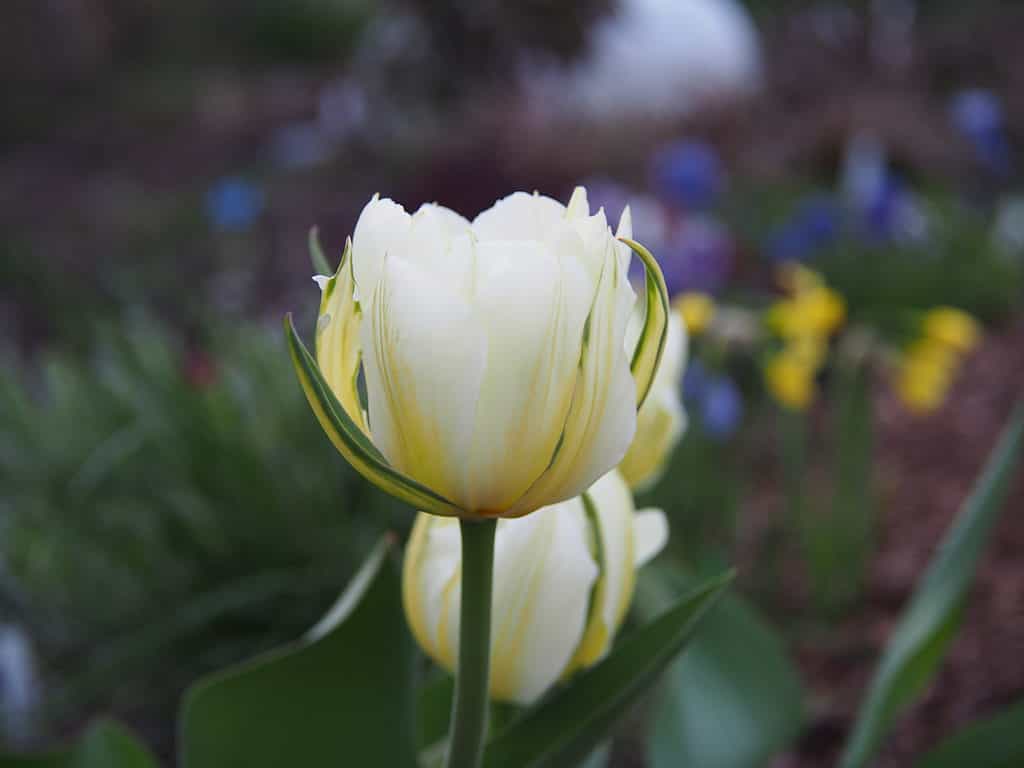
White Exotic Emperor Tulip with yellow accents and green stripes.
©Anna Gratys/Shutterstock.com
Planting Tips
Now that you have some tulip varieties in mind, let’s talk about some best practices to get the most out of your tulip garden next spring.
Bulb Selection
A spectacular tulip display in the spring actually begins in the fall. And it all starts with choosing the right bulbs to plant.
Healthy tulip bulbs are beige-white with a paper-like outer jacket. Larger bulbs have a greater store of nutrients, so they are preferable to smaller, less nutrient-rich bulbs.
Avoid bulbs that are soft and squishy or that have mold spots or other discolorations.
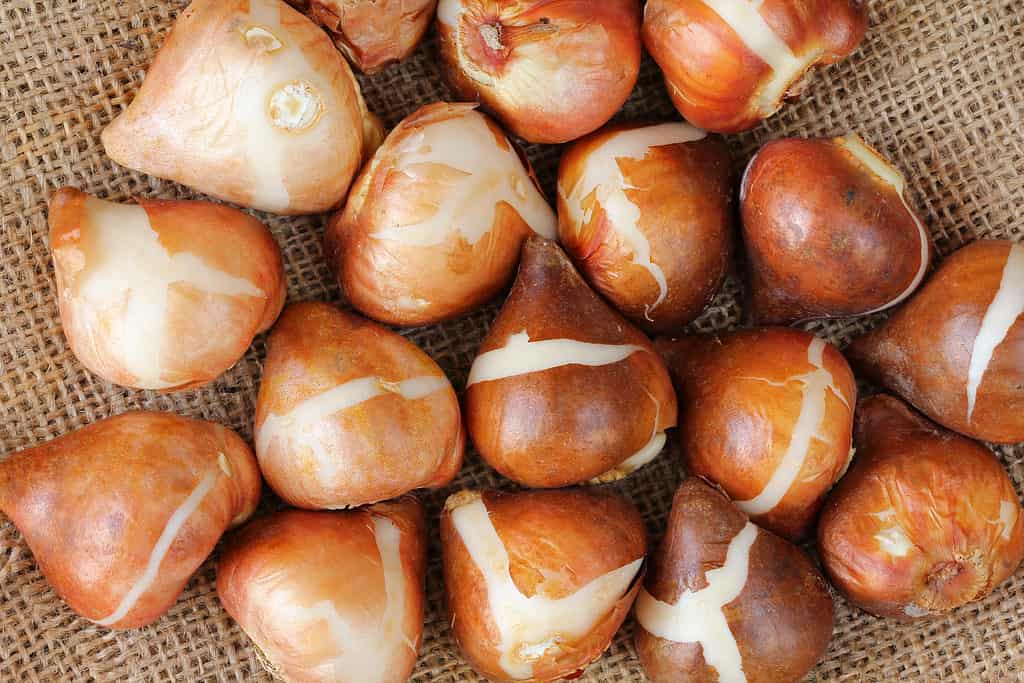
Healthy white tulip bulbs with light brown papery skin.
©sasimoto/Shutterstock.com
When to Plant
Tulip bulbs must experience an extended cold stratification period to emerge from dormancy. Without it, the bulbs won’t break dormancy, and the tulips will not grow.
It’s best to plant bulbs when the soil temperature is below 55°F. This allows the bulbs to root before the ground freezes.
For Nebraska tulip growers, that means that late September through October (possibly early November) is prime bulb planting time.
The best practice is to check the soil temperature in your local area before planting to be certain it’s time to put those bulbs in the ground.
Where to Plant
Tulips need to soak up the sun. So choose a spot where the flowers can catch some rays for at least six hours a day. It’s also important to avoid areas that are prone to standing water. If the soil holds too much moisture, it can lead to fatal bulb rot.
If you want to give your tulips a little extra “oomph,” you can add some fertilizer. A slow-release fertilizer with a nutrient ratio of 9-9-6 is recommended.
If you’d rather use an organic mix, you can use equal parts greensand, bone meal, and blood meal.
Plant the bulbs with the pointed side up about 8-10 inches deep. Space the bulbs 3-4 inches apart.
Perennial Tulips
While tulips are perennials, many gardeners struggle when trying to coax the blooms to return year after year. One of the main reasons for this struggle is often placement.
Tulips (and all other bulbs) thrive when planted in their own area, separate from summer flowers. The flowers that grow during the summer season usually require copious watering. If there are cold-hardy bulbs, like tulips, in that same garden or bed, the bulbs will become waterlogged and rot.
If options are limited and your spring bulbs and summer flowers must share a space, it’s best to choose low-maintenance summer plants that require far less watering. That can protect your bulbs against rot.
And then there’s this: even when tulips do perennialize, they are rather finicky. The biggest and brightest blooms will almost certainly come in the first season, with significantly diminished returns in subsequent years.
Many experienced gardeners have decided that it’s not worth it. So instead of trying to perennialize their tulips, they dig them up after the growing season and plant new bulbs in the fall.

Pinkish yellow Blushing Lady Single Late Tulips bloom in a garden.
©Sergey V Kalyakin/Shutterstock.com
When in Bloom
Tulips break through the ground’s surface in the spring, which is a rather unpredictable season in Nebraska. It can be difficult when you see fledgling tulips growing in your garden on a sunny day, knowing there is a cold, frosty night on the way.
What do you do if your tulips start poking through the ground ahead of a freeze? It may be hard to believe, but the best thing to do is often nothing at all.
Tulip bulbs are hardy, meaning they can handle the wild weather swings that can happen during springtime in Nebraska. In fact, well-meaning growers can often do more damage by covering these flowers with a sheet or blanket than by leaving them exposed to the cold.
While exceptions are to be made in cases of extreme cold, the most helpful thing you can do for your tulips is often to leave them alone and let them do what hardy bulbs do.
Toxicity
Tulip bulbs contain alkaloid and glycoside compounds that are mildly toxic to humans and moderately toxic to pets.
Gardening gloves are highly recommended when handling bulbs or blooms to prevent “tulip fingers,” a skin rash well-known to tulip growers.
Common Pests
Aphids
Aphids will suck the juices out of the tulip plant. In large numbers, they can damage or even destroy tulips.
They can also carry the tulip-breaking virus (TBV). TBV creates broken, striped patterns on the flowers that can actually appear quite beautiful. In fact, infected flowers were once high-sought after due to their unique appearance. This was stopped long ago, though, because of the destruction and spread of this virus. Any tulip infected with TBV should be destroyed. Otherwise, the virus will spread to other flowers.
Small aphid infestations can be treated by dipping a cotton swab in rubbing alcohol and applying it directly to the pests.
For larger aphid problems, spraying insecticidal soap on the plants is effective and also eco-friendly.
Spider Mites
These pests also suck juices from tulip leaves. If yellow or white specks start showing up on the leaves, your tulips may be infested with spider mites.
Insecticidal soap is also effective at controlling these outbreaks (even though spider mites are technically arachnids, not insects).
Wildlife Problems
While diverse and wonderful, Nebraska wildlife can present problems for tulip gardeners.
Squirrels love to dig up freshly-planted tulip bulbs in the fall. However, as recommended above, planting at a deeper depth can deter these rodents.
Rabbits are more of an issue in the spring, as they love to munch on the tender tulip shoots when they first break through the soil’s surface.
Mule deer and white-tailed deer can also destroy your tulip garden. When tulips begin to grow, deer will pull them out of the ground, bulb and all.
To keep the rabbits and deer at bay, you could use a repellent that is available at your local nursery or retailer. Be sure to read and follow the label directions. The repellent may not stop every bunny and deer from perusing your tulips, but it could certainly slow them down.
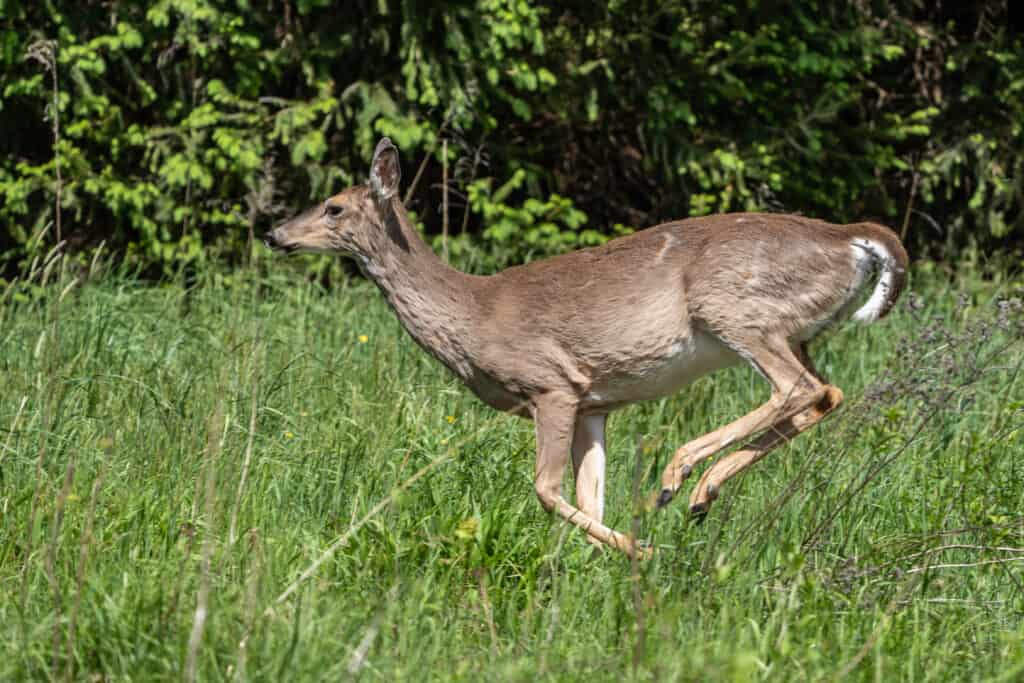
White-tailed deer leaping through a field.
©Amy Lutz/Shutterstock.com
Final Thoughts
Nebraska truly is a tulip utopia. No matter where you are in the Cornhusker State, you can grow a stunning tulip display next spring that will be the envy of your neighborhood!
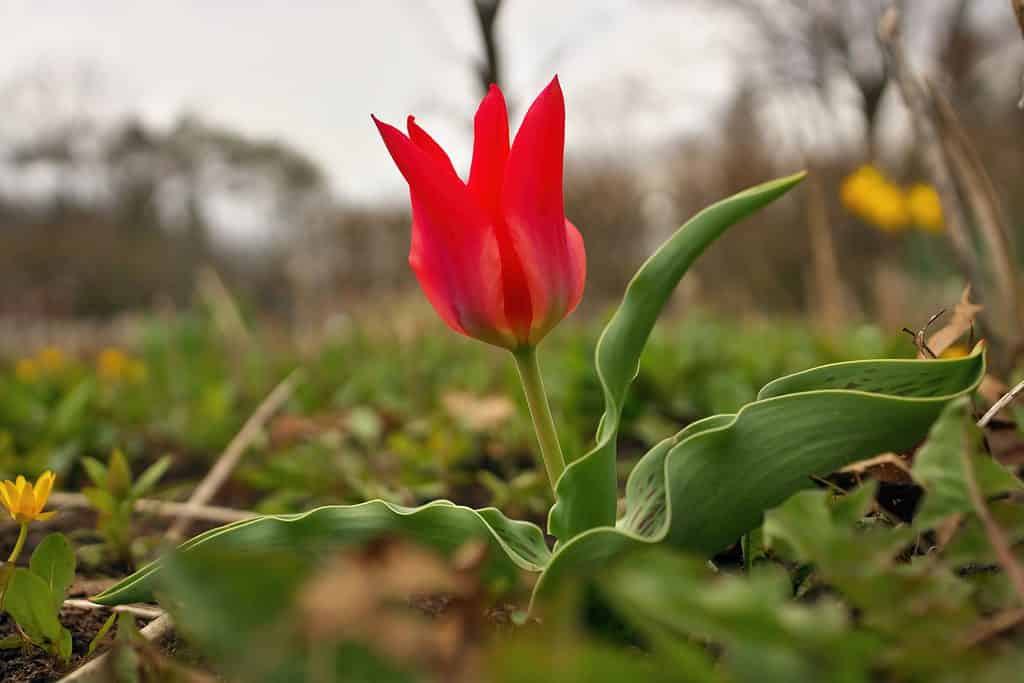
A lone Red Riding Hood Tulip.
©Mark van Dam/Shutterstock.com
The photo featured at the top of this post is © MBL1/Shutterstock.com
Thank you for reading! Have some feedback for us? Contact the AZ Animals editorial team.







